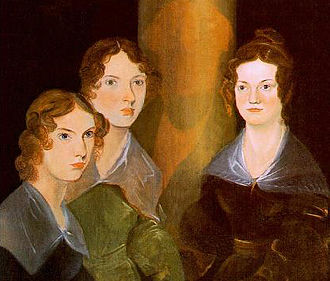"Literature cannot be the business of a woman's life, and it ought not to be. The more she is engaged in her proper duties, the less leisure will she have for it even as an accomplishment and a recreation." Robert Southey to Charlotte Brontë
In what ways has Charlotte Brontë sought to circumvent sexist prejudice against female novelists?
How does Brontë develop Jane Eyre's character while countering the prevailing sexism of her time?
The eldest Brontë children, Maria and Elizabeth (aged 11 and 10)--after enduring physical privations at Cowan Bridge School-- died of tuberculosis in 1825. The fictional Lowood Institute and the character of Helen Burns in Jane Eyre may be Charlotte's heartfelt tribute to her deceased siblings.
|
Which Victorian novels feature a governess?
|
Unit 1
|
Ch. 1
|
By 1849, Charlotte endured the loss of all her surviving siblings: Patrick "Branwell," Emily, and Anne all perished within half a year.
|
Unit 1 Assessments
|
Unit 2
|
Ch. 11
|
Bad, Mad, Brooding Byronic Heroes1. Who was the eponymous George Gordon Byron?
|
In what ways is Mr. Rochester a Byronic hero? How does this introduction characterize him?
|
Unit 2 Assessment: three body paragraphs
In what ways does the text portray different social classes and classism in Chapters 11-22?
Although she is not a family member of the manor, her genteel birth and education place Jane above the working class; nonetheless, her standing as a governess places her among the working class. By analyzing her interactions with the upper class characters (such as Edward Rochester and the Ingrams) and with the working-class characters (Mrs. Fairfax and the household staff she supervises), discuss the ways in which social class and economy affect Jane's life in Thornfield.
Unit 3
|
Ch. 23
|
Unit 3 Assessment: A Literary Analysis of a Mad, Bad, and Crazy Character
1. A graphic organizer that you will use as the notes for the oral presentation (100 points)
This graphic organizer should clearly evince the lists of direct and indirect characterization of the focal character, the conflicts and desires that affect the character, and the focal characcter's interaction with another character.
2. A four-minute oral analysis essay that is saved as an MP 3 file (100 points)
Introduce yourself and deliver your character analysis before wrapping up your oral essay.
Text Options:
1. Edgar Allen Poe, "Tell-tale Heart"
2. Charlotte Perkins Gilman, "The Yellow Wall-paper"
3. Toy Story 3 and Lotso
4. The Lord of the Rings and Gollum
5. Avengers: Endgame and Thanos
Unit 4
|
Chapters 28-29:
|
Unit 4 Assessment: Respond to one of the following prompts by using Jane Eyre as your text.
1) In many novels and plays, minor characters contribute significantly to the total work. They often have particular functions, e.g., as instruments in the plot, foils to the main characters, commentators on the main action and theme, and the like. Write a well-organized essay showing how three minor characters function in the work in which they appear.
2) Many works of literature contain a character who intentionally deceives others. The character’s dishonesty may be intended either to help or to hurt. Such a character, for example, may choose to mislead others for personal safety, to spare someone’s feelings, or to carry out a crime. Choose a novel or play in which a character deceives others. Then, in a well-written essay, analyze the motives for that character’s deception and discuss how the deception contributes to the meaning of the work as a whole.
3) It has often been said that what we value can be determined only by what we sacrifice. Consider how this statement applies to a character from a novel or play. Select a character that has deliberately sacrificed, surrendered, or forfeited something in a way that highlights that character’s values. Then write a well-organized essay in which you analyze how the particular sacrifice illuminates the character’s values and provides a deeper understanding of the meaning of the work as a whole.
4) A bildungsroman, or coming-of-age novel, recounts the psychological or moral development of its protagonist from youth to maturity, when this character recognizes his or her place in the world. Select a single pivotal moment in the psychological or moral development of the protagonist of a bildungsroman. Then write a well-organized essay that analyzes how that single moment shapes the meaning of the work as a whole.
5) Palestinian American literary theorist and cultural critic Edward Said has written that “Exile is strangely compelling to think about but terrible to experience. It is the unhealable rift forced between a human being and a native place, between the self and its true home: its essential sadness can never be surmounted.” Yet Said has also said that exile can become “a potent, even enriching” experience. Select a novel, play, or epic in which a character experiences such a rift and becomes cut off from “home,” whether that home is the character’s birthplace, family, homeland, or other special place. Then write an essay in which you analyze how the character’s experience with exile is both alienating and enriching, and how this experience illuminates the meaning of the work as a whole. Do not merely summarize the plot.
6) A symbol is an object, action, or event that represents something or that creates a range of associations beyond itself. In literary works a symbol can express an idea, clarify meaning, or enlarge literal meaning. Select a novel or play and, focusing on one symbol, write an essay analyzing how that symbol functions in the work and what it reveals about the characters or themes of the work as a whole. Do not merely summarize the plot.
7) In many works of literature, a physical journey–the literal movement from one place to another–plays a central role. Choose a novel, play, or epic poem in which a physical journey is an important element and discuss how the journey adds to the meaning of the work as a whole. Avoid mere plot summary.
8) In many works of literature, past events can affect, positively or negatively, the present activities, attitudes, or values of a character. Choose a novel or play in which a character must contend with some aspect of the past, either personal or societal. Then write an essay in which you show how the character’s relationship to the past contributes to the meaning of the work as a whole.
|
|
|
Visit Lit2go to read and listen to a chapter at a time:
| |||||||
| jane_eyre_full_text.pdf | |
| File Size: | 2308 kb |
| File Type: | |












